Are you a Quiet Speculation member?
If not, now is a perfect time to join up! Our powerful tools, breaking-news analysis, and exclusive Discord channel will make sure you stay up to date and ahead of the curve.
Kaldheim is finally here and legal, and there's a lot to unpack in this relatively innocuous set. Among the cards I'm most excited for are a set of juicy effect lands, an intriguing foretell spell, some promising hate cards, and a new cycle of Gods more tailored to Modern than any previous incarnation. Let's dive in!

Landing Strip
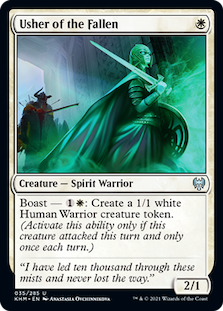 Let me just say: we've come a long way from the days of Savannah Lions. White weenies are more pushed than ever, with today's marquee example being Usher of the Fallen, a W-costed 2/1 with relevant typing and a token-generating effect that's sure to come up over the course of a tournament.
Let me just say: we've come a long way from the days of Savannah Lions. White weenies are more pushed than ever, with today's marquee example being Usher of the Fallen, a W-costed 2/1 with relevant typing and a token-generating effect that's sure to come up over the course of a tournament.
While that about does it for pushed creatures, Kaldheim does feature a set of lands that greatly reward players for dipping into multiple colors. It seems Wizards seriously weighed the drawbacks of entering the battlefield tapped and running a multi-color manabase when they designed this cycle, as the effects they provide are probably enough to ensure the uncommons see Modern play.
Port of Karfell
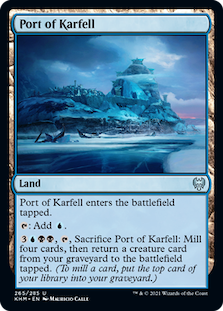 First up is Port of Karfell, a tapland which produces blue mana. Later in the game, so long as players have black mana kicking around, it sacrifices itself to reanimate a creature. Reanimate a creature! On a color-producing land!
First up is Port of Karfell, a tapland which produces blue mana. Later in the game, so long as players have black mana kicking around, it sacrifices itself to reanimate a creature. Reanimate a creature! On a color-producing land!
Since it enters tapped, Port is probably best-suited to combo-control decks that want to interact heavily but end the game with a reanimation effect. At present, few such decks exist in Modern. But we have decks like Ad Nauseam that happily run taplands (Temples) that advance their combo plan (in that case, by finding pieces), so I would bet Port is more of a "when" card than an "if."
It's not exactly Tier 1, but I do believe the Gyruda, Doom of Depths combo deck full of Clone effects will want this land, since it already misses turns by nature of its companion restriction. Gyruda is an "enters" trigger, and not a "cast" trigger, so even if opponents counter or strip the Kraken, Port offers players another way to access it.
Surtland Frostpyre
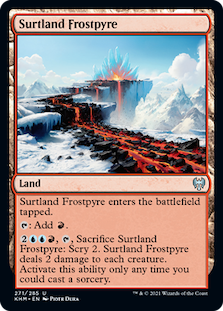 Like Port of Karfell, Surtland Frostpyre seems most at home in combo-control decks, but it has a much more forgiving color requirement. 2 damage to each creature is often enough to dismantle a board out of creature combo decks, so once Frostpyre hits the battlefield, opponents are likely to be wary of how they deploy threats. In this way, the land generates a tempo advantage without necessarily being sacrificed, which can compensate for entering tapped.
Like Port of Karfell, Surtland Frostpyre seems most at home in combo-control decks, but it has a much more forgiving color requirement. 2 damage to each creature is often enough to dismantle a board out of creature combo decks, so once Frostpyre hits the battlefield, opponents are likely to be wary of how they deploy threats. In this way, the land generates a tempo advantage without necessarily being sacrificed, which can compensate for entering tapped.
Then there's scry 2, a useful clause for digging up the right cards. I feel like some decks that might want this are the URx combo-control piles that replaced Splinter Twin, including Through the Breach and Kiki-Exarch. More dedicated combo strategies which lack a control bent, such as Storm, won't be interested.
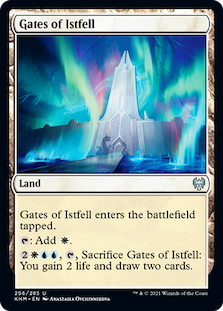
Gates of Istfell
Next up is Gates of Istfell, more of a mid-game speed boost for control decks than anything. Control decks considered running Blighted Cataract in the past, and Gates gives that land a new spin: it enters tapped, sure, but then produces colored mana, and costs one less to sacrifice (sort of offsetting its primary drawback). Of course, players need to be in UW to wield it, unlike Cataract, but for decks that are, that's no problem. Celestial Colonnade: just how much worse is Gates? And would you run 5+?
Skemfar Elderhall
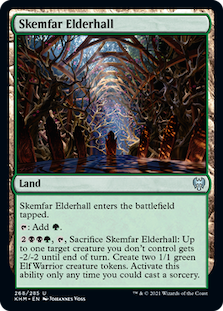 Skemfar Elderhall has got to be a consideration for Elves going forward. A tapland in Elves? You betcha! The deck certainly floods if its lords are removed, so having lands around to channel into board presence will be greatly appreciated. And it also mulligans into dorks, making Skemfar a good way to claw back into the game.
Skemfar Elderhall has got to be a consideration for Elves going forward. A tapland in Elves? You betcha! The deck certainly floods if its lords are removed, so having lands around to channel into board presence will be greatly appreciated. And it also mulligans into dorks, making Skemfar a good way to claw back into the game.
Most importantly, Elves will benefit greatly from both effects on this card. When it's sacrificed, they make a couple of tokens, which can be potent beaters alongside Lords or an army of buddies. And Skemfar doesn't stop there, giving an opponent's threat -2/-2. Since Elves is something of a combo deck, having the ability to remove annoying hatebears like Aven Mindcensor (which prevents searching) or Phyrexian Revoker (who can hold off an Eladamri alpha-strike) should give the deck a boost in playability.
Foretell Ur Information
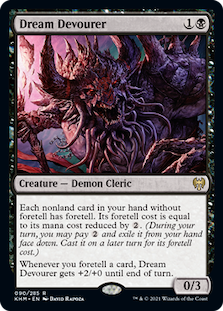 The flagship new mechanic in Kaldheim, and mostly serves as a layaway-plan service for pricey spells. At least, given Dream Devourer and the large amount of unexciting three- and four-drops, it seems like that's how Wizards intended it: players can pay 2 mana when they have it, and then "complete" casting the spell at a later date. In some cases, the process leads to landing your four-drop a turn early, but it was still overpaid for in terms of mana (none of these cards have a very impressive rate). The main exception is Behold the Multiverse, a flexible instant sure to surface in the control builds that already run four-mana draw spells.
The flagship new mechanic in Kaldheim, and mostly serves as a layaway-plan service for pricey spells. At least, given Dream Devourer and the large amount of unexciting three- and four-drops, it seems like that's how Wizards intended it: players can pay 2 mana when they have it, and then "complete" casting the spell at a later date. In some cases, the process leads to landing your four-drop a turn early, but it was still overpaid for in terms of mana (none of these cards have a very impressive rate). The main exception is Behold the Multiverse, a flexible instant sure to surface in the control builds that already run four-mana draw spells.
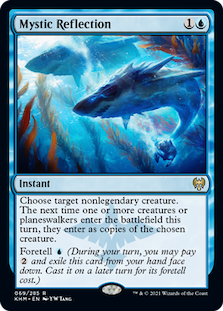 Right Back Atcha
Right Back Atcha
In terms of missed opportunities, Wizards didn't get too creative with funky casting costs. But they did print a decisively funky foretell spell in Mystic Reflection, which content outlets have compared to being a counterspell, a removal spell, and a combo component all in one, joining Tibalt's Trickery as an oddball instant. Indeed, it can function as all of these things! But getting it to do everything for a deck requires some building around. Any ideas, Nexites?
Hi Hater
There's no Grafdigger's Cage or Ancient Grudge in Kaldheim! But there are a couple of interesting hate cards, and it's great to see Wizards is still exploring new design space with these.
Weathered Runestone
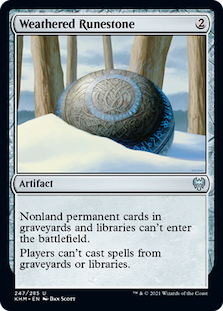 Weathered Runestone does come off as a Cage retrain; it costs an extra mana, which given Damping Sphere seems like the price point Wizards is comfortable with for colorless lock pieces. Still, it's not necessarily strictly worse than grandaddy Cage. While Cage only prevents creature permanents from entering the battlefield from graveyards and libraries, Runestone prevents all nonland permanents, which extends to planeswalkers, artifacts, and enchantments.
Weathered Runestone does come off as a Cage retrain; it costs an extra mana, which given Damping Sphere seems like the price point Wizards is comfortable with for colorless lock pieces. Still, it's not necessarily strictly worse than grandaddy Cage. While Cage only prevents creature permanents from entering the battlefield from graveyards and libraries, Runestone prevents all nonland permanents, which extends to planeswalkers, artifacts, and enchantments.
Still, I don't think that increase in reach is enough to guarantee much play for Runestone. If it prevented lands it would be a hot commodity, shutting off fetchlands (!!!) as well as utility such as Crucible of Worlds. As things stand, I can't think of many decks that cheat planeswalkers into play from the library, although Lurrus has recurred Wrenn and Six under my watch, and Whir of Invention certainly hates facing down this artifact.
Masked Vandal
 Up next is Masked Vandal, a standard two-drop that pops an artifact or enchantment when it enters the fray. Also worth noting is that Vandal exiles the target, which in this day and age is a big upgrade over destroy.
Up next is Masked Vandal, a standard two-drop that pops an artifact or enchantment when it enters the fray. Also worth noting is that Vandal exiles the target, which in this day and age is a big upgrade over destroy.
What's truly unique about Vandal is its changeling ability, which lets it potentially fit into any tribal creature strategy. Changeling on a useful bear can be make-or-break, as we saw with the Humans, Merfolk, and Spirits-approved Unsettled Mariner. The only of those decks capable of producing green reliably is Humans, although we've seen the other two splash the color for Collected Company or other random tribesmen. Vandal probably won't have the same impact as Mariner, but it's definitely a card to watch out for, and one that will make its way into a few tribal lists. (Including Elves!)
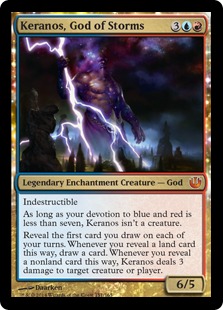
Gods Forbid
Kaldheim's big selling point is the return of Gods, now in a two-sided package that gives players extra bang for their buck. While Gods have traditionally been expensive haymakers like Keranos, God of Storms, the Kaldheim ones are priced like regular Standard powerhouses, mostly sitting around the 3-4 mana mark. And they've got the added utility of being another spell should players lack even that kind of mana, a trait that makes them much more attractive to Modern decks.
Halvar, God of Battle / Sword of the Realms
 Halvar is a four-mana 4/4 that grants double strike to the pilot's equipped or enchanted creatures. As a bonus, it attaches one of those already-attached cards to another creature at the beginning of combat, should players want. While that second ability's nothing to write home about, the first one definitely is, especially considering the equipment that's currently played in Modern.
Halvar is a four-mana 4/4 that grants double strike to the pilot's equipped or enchanted creatures. As a bonus, it attaches one of those already-attached cards to another creature at the beginning of combat, should players want. While that second ability's nothing to write home about, the first one definitely is, especially considering the equipment that's currently played in Modern.
Stoneforge Mystic's main objective in this format is to search up and cheat out Batterskull, a 4/4 vigilance lifelinker. With double strike, that germ turns a favorable board position into an insurmountable lead.But it's not like players even have to run a random 4/4 to assemble the combo, thanks to Halvar's other side: Sword of the Realms.
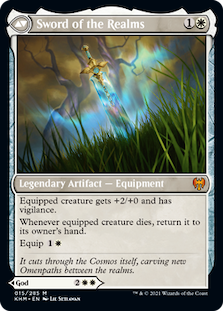
Sword is a sort-of playable equipment in its on rite, costing two mana to play or equip, and giving +2/+0 and vigilance to its holder. Even better, it returns the holder to the hand when it dies. That means Sword can be found with Stoneforge, so players only need run a single copy, and it stands to generate quite a bit of value on its own; slap one on your Stoneforge and opponents will be terrified of killing the 3/2, which now returns to the hand so it can search up a Batterskull and then loop itself all over again. In a deck with more creatures, the possibilities expand, as there are surely even better targets to grace with immortality.
Egon, God of Death / Throne of Death
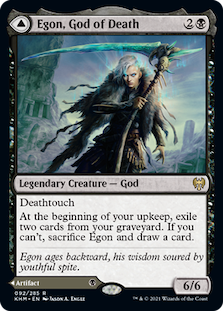 Egon is a three-mana 6/6 with the drawback of taxing players to self-exiles from the grave each upkeep. By itself, Egon would be severely outclassed by Rotting Regisaur, which sees play in Unearth decks for its massive bulk. But if players can't or won't pay the upkeep cost, Egon trades into a new card, potentially even acting as a slow-trip for something more useful in tight situations. These many modes give the card added utility.
Egon is a three-mana 6/6 with the drawback of taxing players to self-exiles from the grave each upkeep. By itself, Egon would be severely outclassed by Rotting Regisaur, which sees play in Unearth decks for its massive bulk. But if players can't or won't pay the upkeep cost, Egon trades into a new card, potentially even acting as a slow-trip for something more useful in tight situations. These many modes give the card added utility.
If that wasn't enough, though, Egon has a whole second side with Throne of Death, a one-mana artifact that mills pilots 1 on each upkeep. Besides generating velocity, Throne is also a draw engine, as players can pay 2B, tap it, and exile a creature from their graveyards to draw a card. As a one-mana artifact, I wonder if Throne itself doesn't have enough flexibility to make the cut in Urza-powered shells, which would have to go black to accommodate it. The milling fuels Uro and Emry, and Throne can be tapped for mana with Urza in play. Plus, there's the option of just dropping a 6/6 on dudes!
Birgi, God of Storytelling / Harnfel, Horn of Bounty
 Birgi, God of Storytelling is the most combo-slanted of the Gods, and both sides seem tailor-made for a deck Wizards is supposedly allergic to: Storm. Birgi is a three-drop that adds R whenever players cast a spell, tying it in with Storm's other ritual creatures, Goblin Electromancer and Baral, Chief of Compliance. While those guys cost two and not three, they only give players an extra mana when a spell costing two or more is cast; conversely, Birgi adds a mana even when cantrips are cast, meaning the third mana spent to resolve it will probably pay for itself pretty fast on a combo turn. Still, players will have to wait an extra turn before going off, which could be a dealbreaker.
Birgi, God of Storytelling is the most combo-slanted of the Gods, and both sides seem tailor-made for a deck Wizards is supposedly allergic to: Storm. Birgi is a three-drop that adds R whenever players cast a spell, tying it in with Storm's other ritual creatures, Goblin Electromancer and Baral, Chief of Compliance. While those guys cost two and not three, they only give players an extra mana when a spell costing two or more is cast; conversely, Birgi adds a mana even when cantrips are cast, meaning the third mana spent to resolve it will probably pay for itself pretty fast on a combo turn. Still, players will have to wait an extra turn before going off, which could be a dealbreaker.
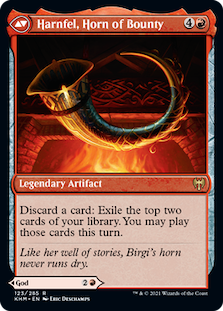 On the literal flip side, the five-mana Harnfel, Horn of Bounty gives the card some extra utility where a mana creature would be redundant or less useful. The Horn lets players discard a card to essentially draw 2 on a combo turn; in other words, it greatly reduces chances of fizzling. Having this kind of haymaking back-end may well make Birgi an attractive option over Electromancer and Baral.
On the literal flip side, the five-mana Harnfel, Horn of Bounty gives the card some extra utility where a mana creature would be redundant or less useful. The Horn lets players discard a card to essentially draw 2 on a combo turn; in other words, it greatly reduces chances of fizzling. Having this kind of haymaking back-end may well make Birgi an attractive option over Electromancer and Baral.
Heaven on Earth
Yes, it's true: Kaldheim lacks alarm-raising brokenness, at least at first look. But there's plenty of toys here for Modern players, and it will be fun to watch the set shake itself into the Leagues over the coming weeks!




